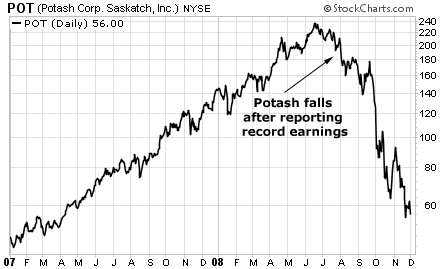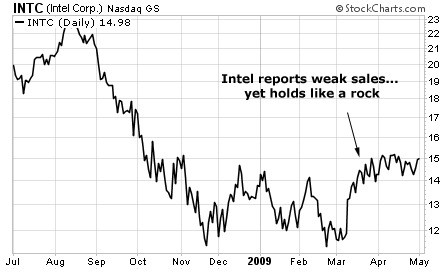
IPFS
The Only Way to Trade on the News
Written by Sierra Hancock Subject: Economy - Economics USA
The Only Way to Trade on the News


Editor's note: A common mistake novice traders make
is to read something in the paper about how a company is doing well...
and then go and buy some shares. The thing is, trading after news comes
out is usually missing the party. The market leads the news, not the
other way around. In today's "common sense" trading lesson, we study the seasoned trader's way to use the news.
On July 24, 2008, Potash came out with a stunning earnings report.
As we showed you yesterday,
fertilizer maker Potash Corp. was in the middle of a huge bull market
back in mid-2008. Shares were up 600% over the previous two years. Tons
of CNBC guests talked about how bullish they were on fertilizer stocks.
You'd hear stuff like, "Things couldn't be better for the industry."
Retail investors across the country started hearing about high crop
prices and rising fertilizer shares on the nightly news... and they
started reading about them in the local paper.
Food riots broke out in Mexico and Indonesia. Fertilizer companies
were reporting incredible increases in revenue and profits. The Market
Vectors fund family even launched a new agribusiness fund to capitalize
on investor interest toward the sector.
Then... Potash announced monster earnings.
The company had made $905.1 million... a 220% increase from the year before and the highest total in company history. "This quarter established a new standard of performance for our company," CEO Bill Doyle said.
Shares fell 3.3% on massive trading volume as a result.
You read that correctly. Potash reported the greatest quarter in
company history... a "new standard" in profitability... and was
clobbered for it.
This horrible performance in the face of great news is what happens when a trend is changing. It is called "acting poorly"...
and it's a huge bearish sign for that market. It's a sign that all the
great news and all the great fundamentals going for the market have been
"priced in." It's a sign there aren't enough buyers in the market to
help drive prices higher. They've been exhausted.
We'll take another look at Potash shares for a reminder of what can
happen when a bull market can't climb higher on terrific news:

Just as it's bearish for a bull market to fall on great news, it's bullish for a bear market to rally on horrible news.
Consider the case of Intel...
In April 2009, things were horrible for Intel. The credit crisis
was in full swing. Many folks were worried the "The Great Depression
Part II" was around the corner. Intel shares had fallen more than 50% in
four months.
Intel is the world's largest maker of semiconductors... the tiny
"engines" that power the world's computers. If another Great Depression
was in the cards, people wouldn't be buying many computers... and
Intel's business would suffer.
In mid-April, Intel reported a huge quarterly sales decline of 26%
from the previous year's quarter. Profits fell 55%. Intel also offered a
"blurry" outlook for the rest of the year. Wall Street hates "blurry."
So what happened to Intel shares after this news? They held like a rock!

When a bear market has a bullish reaction to horrible news, it's
"acting well." It's a sign the sellers of that asset are exhausted and
out of ammo. It's a sign the downtrend is likely finished.
In Intel's case, the downtrend was finished. The stock rallied 50%
over the next 12 months and was one of the top-performing stocks of the
year. This rally kicked off when Intel started "acting well."
To sum things up, when a bull market sells off in the face of great
news, it's a bearish sign. When a bear market rallies in the face of
horrible news, it's a bullish sign.
You won't get an edge in the market by trading off news releases…
unless you put a twist on the idea and look for assets that are "acting
well" or "acting poorly."
Good trading,
Brian Hunt


























